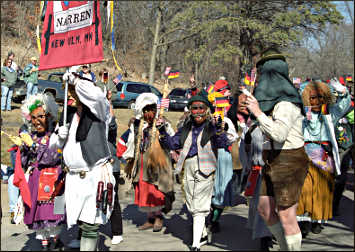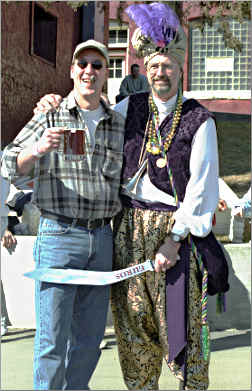A German Mardi Gras
At New Ulm's Bock Fest, the good times roll in on a tide of beer.

© Beth Gauper
Oh, the joy of being German.
There's no question that Germans know how to have a good time. After all, they've given the world Oktoberfest, half-gallon steins and "The Little Chicken Dance."
And what else? Beer, of course, the enjoyment of which is a God-given right to Germans ‐ their adage "Hopfen und Malz, Gott erhalts" roughly translates as "Malt and hops, to God, are tops."
In Minnesota, there's no town more German than New Ulm, which lets le bon temps rouler on a tide of beer during its own brand of Mardi Gras.
In Germany, this Fat Tuesday festival is called Karneval, Fasnacht or, in southern Germany, from which the first Ulmers came, Fasching.
Like Mardi Gras, it mixes ancient pagan rituals with Lenten traditions, which makes it particularly apt in New Ulm. The town is so Catholic and Lutheran that many of its children never set foot in a secular school — and yet its hero, the tribal warrior Hermann, predates Christianity.
Of course, none of this mattered one bit to the thousands of people gathered one late-winter Saturday at August Schell Brewery. The sun was shining, a band was playing and the beer was flowing at a brewery that's been called the most picturesque in the nation.
It was the annual Bock Fest at the Schell Brewery, founded in 1860 and the second-oldest family-owned brewery in the nation.
By noon, hundreds had polished off their first glasses of bock, a caramel-colored beer traditionally drunk in early spring. Hundreds more were off in the forest, looking for seven other bocks.
Bock, in German, also means billy goat, and Ted Marti, great-great-grandson of August Schell, had hidden wooden goat-head cutouts on the grounds and in adjoining Flandrau State Park, good for prizes of $35 to $150.
He'd given out clues — "Eight naked bodies tanning by the trail" and "Out of sight, yet sustained by the brewery" — but they were frustrating the searchers, who were coming out of the brush with nothing but cockleburs.
"Right now, my main objective is to find my way back," said Tom Maloney of nearby Mankato, as he looked for catalpa trees, part of a clue. "But everybody wins today, the weather is so nice."

© Beth Gauper
The trails led along the looping Cottonwood River and into the state park. The Dakota hunted and camped on these prairie bluffs until the U.S.-Dakota Conflict of 1862, when hungry young Dakota plundered and burned the young town of New Ulm.
The Schells, however, had shared food with their Dakota neighbors, and their brewery was unharmed.
Today, this brewery still is a neighborly place; its wooded grounds have been open to the public since they were landscaped in the 1880s. Visitors wander the garden pathways around August Schell's 1885 brick home, admire the peacocks and visit the Museum of Brewing.
On my tour, the guests cheered the guide when she told of the days when horse-drawn carriages delivered beer house to house, just like milk.
Afterward, we guzzled samples of pils, Firebrick lager, German pale ale and Schmaltz's Alt, named for Ted Marti's father, Warren.
Outside, the Bock Fest Boys were revving up the beer-guzzling swarms by playing Johnny Cash's "Ring of Fire" and prompting rounds of the German victory chant "Zicke Zacke, Zicke Zacke, Heu Heu Heu."
There was a parade, too, at which the St. Paul Winter Carnival Vulcans, whose winter-banishing rituals are based on the same traditions that fuel Fasching, joined New Ulm's Narren.
The Narren, or fools, wear folk costumes and hand-carved wooden masks with long, bulbous noses and chins; the effect is both sinister and comic.
By late afternoon, five of the hidden bocks had been captured and returned. Meanwhile, their namesake beer was making the crowd very, very happy.
"I think we all found the bock," said a blissed-out Greg Heilman of Eden Prairie, Minn., dancing in homemade lederhosen and a hunter's cap, in which he'd stuck a small German flag.
The party continued that evening in downtown bars and at Turner Hall, named for the group of German socialists and freethinkers who, in 1854, founded the town.
The Concord Singers, known as one of the foremost German-language male chorus in America, are the official hosts of Fasching, and they presided over the lighthearted singing, dancing and costume parade at Turner Hall.
It was an evening, said Bob Beussman, for good old German Gemütlichkeit.
"What does that mean?" he asked. "To us, it means the warmth and good times everyone has when they're in the city of New Ulm."
The town holds lots of festivals, including Bavarian Blast in July and, of course, Oktoberfest in fall.
So the only way to avoid wagging elbows to the "Little Chicken Dance" is to visit on quieter weekends.
In summer, Schell's gives daily tours, and the spiral staircase of the 1897 Hermann Monument opens to those who want a magnificent view of the Minnesota River Valley.

© Beth Gauper
Hermann united the Alemannic tribes and routed the Romans in 9 A.D.; he brandishes his sword atop a 70-foot columned dome in Hermann Heights Park.
There's modern history downtown in the Brown County Historical Society, whose stepped gables and bands of brick and white terra cotta make it look like a wedding cake.
Exhibits tell the story of the early settlers and the native Dakota, whose cultures eventually clashed so calamitously.
Across the street, the elegant 1887 John Lind House, the home of Minnesota's 14th governor, is open for tours; so is the 1894 childhood home of Wanda Gag, author and illustrator of the children's classic "Millions of Cats."
The carillon bells of the town Glockenspiel play twice every afternoon as three animated polka-band figures twirl. Shops fill demand for imported German goods. Domeiers, on Minnesota Street, is the best-known; often, bus tours fill the tiny store.
There's not much in the way of German culture the town has overlooked. And why should it? In New Ulm, being German means good times.
Trip Tips: Bock Fest in New Ulm, Minnesota
Getting there: It's 1¾ hours west of the Twin Cities, longer during rush hours.
Bockfest: It's the first Saturday in March.
Brewery tours no longer are offered during the festival, which has become so popular that brewery gates close after capacity is reached and people are admitted only as others leave.
For more on New Ulm, see Where the Germans are.
Schell Brewery tours: The Bier Halle, gift shop and grounds are open daily year-round. Brewery tours are given daily from Memorial Day weekend to Labor Day and Fridays to Sundays the rest of the year, $10.
The brewery also offers an Into the Depths tour on the second or third Thursday of each month, $40, that takes visitors into the historic beer caves and original taproom as well as production facilities.
On the northwest side of town, the Starkeller taproom at 2215 N. Garden St. ages and serves Schell's sour beers.
Accommodations: Bingham Hall B&B is in a stately house on German Street near downtown and has four bedrooms.
At the south end of Broadway, the Microtel Inn has an indoor pool, 507-354-9800, as does the Best Western.
Dining: On Minnesota Avenue downtown, Lola American Bistro serves sandwiches, salads, soups, pasta and dinner entrees.
The Rathskeller at Turner Hall, a block south of downtown at First and State, has a salad bar and serves a German and American menu.
Downtown, George's Fine Steaks & Spirits serves lamb and duck as well as steaks and seafood, 507-354-7440.
Glockenspiel: The bells ring and figures twirl at noon, 3 and 5 p.m.; during festivals, also at 10:30 a.m. and 1 p.m.
Flandrau State Park: The park, which adjoins Schell Brewery in a wooded valley on the edge of town, has campsites, a pool with a sand bottom and 8½ miles of hiking trails, some on a bluff overlooking the Cottonwood River.
Information: New Ulm tourism, 888-463-9856.